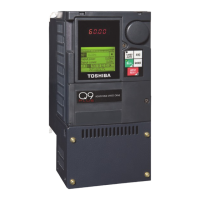https://www.toshiba.com/tic/ 15
Installation and Connections
Q9 Plus ASD Install/Op Manual
Terminal Descriptions
Note: The programmable terminal assignments
may be accessed and changed from their
default settings as mapped on pg. 40 or via
the Direct Access method: Program
Direct Access Applicable Parameter
Number. See the section titled Program
Mode Menu Navigation on pg. 40 for the
applicable Direct Access parameter
numbers.
Note: For further information on terminal
assignments and default setting changes,
see the sections titled Default Setting
Changes on pg. 29 and Input Terminals on
pg. 44.
Note: See the section titled Cable/Terminal
Specifications on pg. 282 for the Q9 Plus
ASD conductor and terminal electrical
specifications.
Note: Throughout the manual descriptions and
examples, the sink mode will be used when
referencing discrete terminal functions.
ST — The default setting for this terminal is the
Standby mode controller. As the default setting, this
terminal must be activated for normal system
operation. The ST terminal is activated by
connecting CC to this terminal (Sink mode). When
deactivated, OFF is displayed on the Frequency
Command screen. This input terminal may be
programmed to any of the functions listed in Table 9
on page 252 (see F113).
RES — The default setting for this terminal is
Reset. The RES terminal is activated by connecting
CC to this terminal (Sink mode). A momentary
connection to CC resets the ASD and any fault
indications from the display. Reset is effective when
faulted only. This input terminal may be
programmed to any of the functions listed in Table 9
on page 252 (see F114).
F — The default setting for this terminal is Forward
run command. The F terminal is activated by
connecting CC to this terminal (Sink mode). This
input terminal may be programmed to any of the
functions listed in (see F111).
R — The default setting for this terminal is Reverse
run command. The R terminal is activated by
connecting CC to this terminal (Sink mode). This
input terminal may be programmed to any of the
functions listed in Table 9 on page 252 (see F112).
S1 — The default setting for this terminal is Fire
Speed. The function of this input as Fire Speed is to
run the motor at the Preset Speed 15 setting upon
activation. Fire Speed activation overrides the Local
and Remote commands (see Figure 28. on pg. 34).
This terminal may be activated by connecting CC to
this terminal (Sink mode) and may be initiated by a
fire alarm signal or fire/smoke sensing device. This
input terminal may be programmed to any of the
functions listed in Table 9 on page 252 (see F115).
S2 — The default setting for this terminal is Preset
Speed Bit 2. The function of this input as Preset
Speed Bit 2, in conjunction with S1, S3, and S4, is
to run the motor at the Preset Speed selection of
the S1 – S4 settings when activated. The terminal is
activated by connecting CC to this terminal (Sink
mode). This input terminal may be programmed to
any of the functions listed in Table 9 on page 252
+SU DC Input
Externally-supplied 24 VDC backup control power (1.1 A max.). An alternative to
the EOI Battery Backup.
P24
DC Output
24 VDC (200 mA max.) output. Figure 14. on pg. 18.
PP
10.0 VDC (10 mA max.) voltage source for the external
potentiometer.
Figure 15. on pg. 18.
FP Pulsed Output
Output Frequency — Multifunctional programmable output
pulse train of a frequency based on the output frequency
(see Table 10 on page 255).
Figure 17. on pg. 18.
IICC — Return for the V/I input terminal.
DO NOT
connect to
Earth Gnd
or to each other.
CCA — Return for the RR, RX, P24, and the PP terminals.
CC —
Return for the AM, FM, +SU, and the discrete input
terminal.
Table 2. Terminal Board Names and Functions. (Continued)
Terminal
Name
Input/Output
Function (Default Setting If Programmable)
(see Terminal Descriptions on pg. 15)
Circuit Config.
IICC
CCA
CC
ST
RES
F
R
S1
S2

